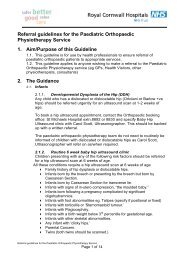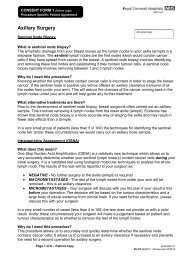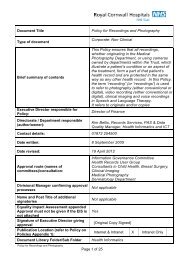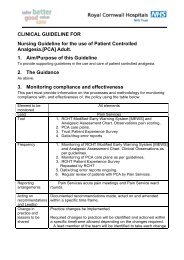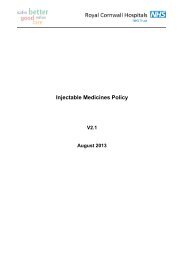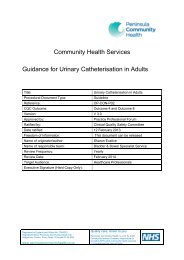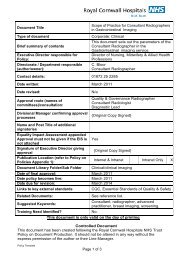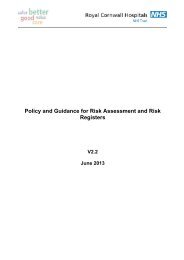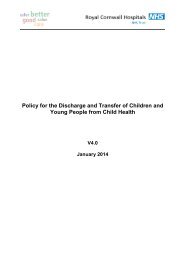Procedure for Heel Prick Sampling
Procedure for Heel Prick Sampling
Procedure for Heel Prick Sampling
Create successful ePaper yourself
Turn your PDF publications into a flip-book with our unique Google optimized e-Paper software.
CLINICAL GUIDELINE FOR HEEL PRICK SAMPLING IN<br />
INFANTS AND CHILDREN.<br />
1. Aim/Purpose of this Guideline<br />
1.1 <strong>Heel</strong> prick sampling can be used to obtain capillary blood from a neonate or infant. The<br />
sample may be used <strong>for</strong> a range of tests (e.g. serum bilirubin, drug levels) or as part of a<br />
screening programme. If the foot is well perfused it will give an accurate pH and Co2<br />
measurement <strong>for</strong> blood gas tests. The aim of this guideline is to provide clear and<br />
standardised guidance <strong>for</strong> all health care professionals per<strong>for</strong>ming this procedure, using<br />
up to date evidence from research.<br />
1.2 This guidance applies to all health care professionals per<strong>for</strong>ming this procedure. It is<br />
the responsibility of those undertaking heel prick sampling to have achieved competency<br />
in the procedure. The nursing/midwifery staff caring <strong>for</strong> the patient must ensure the<br />
appropriateness of the procedure and follow-up the results, the procedure may be<br />
delegated providing competency has been achieved.<br />
2. The Guidance<br />
2.1Equipment<br />
• Clean gloves and personal protective equipment<br />
• Relevant paediatric blood collection bottles, capillary tube or blood collection<br />
card<br />
• Blood letting device<br />
• Gauze<br />
• Sterile water<br />
• Clean tray to hold equipment<br />
• Sharps disposal box<br />
2.2<strong>Procedure</strong>:<br />
1. The patient should be identified as per Positive Patient Identification Policy and<br />
<strong>Procedure</strong>s. V4: June 2010 and a full explanation of the procedure should be<br />
given to the parents to ensure their consent is obtained as per Policy <strong>for</strong> consent<br />
to examination or treatment. V6.1: June 2011.<br />
2. The request <strong>for</strong>ms should be ordered via the electronic order coms. System. If<br />
hand written the request card must be filled in with all details clearly and in<br />
black ink. If crucial in<strong>for</strong>mation is missing or the test is inadequate a repeat test<br />
may be requested by the laboratory.<br />
3. A clinical hand wash must be per<strong>for</strong>med prior to starting the procedure.<br />
Appropriate personal protective clothing should be worn (e.g. Gloves, apron).<br />
Clinical guideline <strong>for</strong> heel prick sampling in infants and children.<br />
Page 1 of 9
4. The heel should be cleaned with sterile water and gauze. Allow the area to dry.<br />
Alcohol impregnated wipes should not be used, due to absorption and<br />
drying to the skin, association with chemical burns in preterm infants, minimising<br />
chemical exposure in the newborn and injury to delicate/healing tissue.<br />
5. Safely position the infant either with a parent or in the cot. If possible encourage<br />
breastfeeding or EBM or skin to skin contact <strong>for</strong> pain relief. Consider using<br />
prescribed oral pain relief i.e. 24% sucrose solution.<br />
6. Select an appropriate site <strong>for</strong> blood sampling. The chosen site should continually<br />
be rotated and free from previous injury.<br />
7. Keeping dominant hand free to carry out the procedure, hold the baby’s heel<br />
firmly and upright in your non dominant hand, hold the ankle with index and<br />
middle finger, and use the other fingers to steady the baby’s leg. Partly encircle<br />
the baby’s heel with thumb,<br />
8. <strong>Prick</strong> the baby’s heel once using an automated blood-letting device that is<br />
appropriate <strong>for</strong> the age and size of the infant (as per manufacturer’s<br />
instructions).<br />
9. Relax tension and wipe away initial blood flow with gauze.<br />
10. Whilst maintaining grip, hold the heel so that blood is allowed to hang. Gently<br />
compress the baby’s heel to <strong>for</strong>m a large droplet of blood- Do not squeeze.<br />
11. Fill Collection sample in the relevant paediatric blood collection tubes or on the<br />
blood collection card.<br />
Note - Change in Recommendations: Warming the heal is not necessary and should be<br />
viewed as unnecessarily prolonging the process as it has no effect on the outcome of the<br />
sampling in terms of time taken to collect a sufficient sample, the number of repeat<br />
samples needed or the infant's behavioural response.<br />
Squeezing the heel in order to encourage blood flow is sometimes necessary, but is<br />
recognised as causing or increasing pain in the neonate .It can also cause haemolysis and<br />
soft tissue damage. The heel should not there<strong>for</strong>e be routinely squeezed, and if it is, then<br />
gentle squeezing and releasing should be used. Ensuring the infant is in a position where<br />
the heel is lower than the body may facilitate blood flow.<br />
Soft paraffin solutions such as Vaseline® should not be used <strong>for</strong> heel punctures, due to<br />
increased risk of infection, altering of blood results and clogging of equipment.<br />
12. Once the samples have been taken, apply pressure the puncture site to stop the<br />
bleeding with gauze.<br />
13. When bleeding has stopped, dispose of all sharps, clinical waste including gloves<br />
and PPE. Hands must then be re-washed.<br />
14. If used, label tubes whilst at patients’ bedside. Place collection tubes/card in the<br />
plastic sleeve attached to the request card and seal be<strong>for</strong>e sending <strong>for</strong> analysis.<br />
15. Document the procedure within Patients’ notes as per Clinical record keeping<br />
policy.May2012.<br />
Clinical guideline <strong>for</strong> heel prick sampling in infants and children.<br />
Page 2 of 9
2.3 Acceptable Sites <strong>for</strong> <strong>Sampling</strong><br />
<strong>Heel</strong> lancing should be limited to the medial and lateral borders of the heel (please<br />
see diagram above.)<br />
In preterm infants, who undergo many repeated capillary blood samples during the<br />
course of their care, the close clustering of puncture sites may lead to significant<br />
trauma and tissue injury over time. Newer devices have been introduced <strong>for</strong> heel<br />
lancing that limit the depth of penetration of the blade (generally to a depth of<br />
2.4mm), there<strong>for</strong>e reducing the risk of inadvertent injury to deep structures, including<br />
the calcaneum. Capillary blood sampling may generally be safely carried out over the<br />
whole of the heel pad, allowing repeated samples to be taken over a wider area and<br />
reducing the trauma to the heels overall.<br />
Clinical guideline <strong>for</strong> heel prick sampling in infants and children.<br />
Page 3 of 9
3. Monitoring compliance and effectiveness<br />
Element to be<br />
monitored<br />
Lead<br />
Adherence to full guideline<br />
Ward managers<br />
Tool<br />
Frequency<br />
Reporting<br />
arrangements<br />
Acting on<br />
recommendations<br />
and Lead(s)<br />
Audit and weekly safety audits<br />
Annually<br />
Ward Mangers. Lead Nurse. Practice development <strong>for</strong>um.<br />
Ward Mangers. Lead Nurse. Practice development <strong>for</strong>um<br />
Change in practice<br />
and lessons to be<br />
shared<br />
Required changes to practice will be identified and actioned within 3-6<br />
months. A lead member of the team will be identified to take each<br />
change <strong>for</strong>ward where appropriate. Lessons will be shared with all the<br />
relevant stakeholders<br />
4. Equality and Diversity<br />
4.1 This document complies with the Royal Cornwall Hospitals NHS Trust service Equality and<br />
Diversity statement.<br />
4.2 Equality Impact Assessment<br />
The Initial Equality Impact Assessment Screening Form is at Appendix 2.<br />
Clinical guideline <strong>for</strong> heel prick sampling in infants and children.<br />
Page 4 of 9
Appendix 1. Governance In<strong>for</strong>mation<br />
Document Title<br />
Date Issued/Approved: 1 September 2013<br />
Clinical Guideline <strong>for</strong> <strong>Heel</strong> <strong>Prick</strong> <strong>Sampling</strong> in<br />
Infants and Children.<br />
Date Valid From: 1 September 2013<br />
Date Valid To: 1 September 2016<br />
Directorate / Department responsible<br />
(author/owner):<br />
Tabitha Fergus-Child Health<br />
Contact details: 01872 25 2800<br />
Brief summary of contents<br />
Guideline outlining best practice and full<br />
guidance in obtaining a heel prick sample<br />
from an Infant or Child.<br />
Suggested Keywords:<br />
Target Audience<br />
Executive Director responsible <strong>for</strong><br />
Policy:<br />
Neonate<br />
Child<br />
<strong>Heel</strong> prick<br />
Blood sample<br />
RCHT PCT CFT<br />
<br />
Medical Director<br />
Date revised: August 2013<br />
This document replaces (exact title of<br />
previous version):<br />
Approval route (names of<br />
committees)/consultation:<br />
Divisional Manager confirming<br />
approval processes<br />
<strong>Procedure</strong> <strong>for</strong> heel pricks sampling.<br />
Senior nursing staff Child Health and<br />
Neonatal Unit.<br />
Paediatric consultants<br />
Child Health Audit and Guidelines<br />
Practice development <strong>for</strong>um<br />
Name and Post Title of additional<br />
signatories<br />
Signature of Executive Director giving<br />
approval<br />
Publication Location (refer to Policy<br />
on Policies – Approvals and<br />
Ratification):<br />
Document Library Folder/Sub Folder<br />
Not required<br />
{Original Copy Signed}<br />
Internet & Intranet Intranet Only<br />
Paediatric and neonatal<br />
Clinical guideline <strong>for</strong> heel prick sampling in infants and children.<br />
Page 5 of 9
Links to key external standards<br />
Related Documents:<br />
Training Need Identified?<br />
RCHT Policy <strong>for</strong> consent to examination<br />
or treatment. V6.1:June 2011<br />
RCHT Positive Patient Identification.<br />
Policy and <strong>Procedure</strong>sV4:June 2010<br />
RCHT Clinical record Keeping Policy. May<br />
2012<br />
Association of Women’s Health, obstetric<br />
and neonatal nurses and the national<br />
association of neonatal nurses. 2001.<br />
Evidence based clinical practice guideline:<br />
neonatal skin care.<br />
Barker et al.Warming capillary blood<br />
sample .Should heels be warmed?<br />
Archives of disease in childhood. 2009<br />
Gerds.Nursing care and sensory<br />
enrichment of the normal newborn. In<br />
Reeder. Maternity Nursing.1997<br />
Jain and Rutter.Topical pain relief <strong>for</strong> heel<br />
prick blood sampling. 2001<br />
Great Ormond Street Hospital <strong>for</strong><br />
Children. Blood sampling, neonatal<br />
capillary.<br />
Johnston and Taylor. Skills <strong>for</strong> midwifery<br />
practice. 2000<br />
Vertanen et al.The automatic incision<br />
device <strong>for</strong> obtaining blood samples from<br />
the heel. Archives of disease in<br />
childhood.2001<br />
Warren. Blood without tears. The<br />
practising Midwife.1998<br />
Waughten. Midwives magazine. Royal<br />
college of midwifery. March 2005<br />
Image created by T. Fergus<br />
Yes- All staff will be sent new guidelines<br />
to read and sign off as new practice is<br />
advised.<br />
Version Control Table<br />
Date<br />
Version<br />
No<br />
July 2007 V1.0 Document created<br />
April 2009 V2.0<br />
Sep 2013 V3.0<br />
Summary of Changes<br />
Review and re <strong>for</strong>mat<br />
Review, re <strong>for</strong>mat and re write. Addition of<br />
image.<br />
Clinical guideline <strong>for</strong> heel prick sampling in infants and children.<br />
Page 6 of 9<br />
Changes Made by<br />
(Name and Job Title)<br />
Tabi Fergus and<br />
Practice development<br />
Team<br />
Deputy ward manager<br />
Tabi Fergus<br />
Deputy ward manager<br />
Tabi Fergus<br />
Deputy ward manager
All or part of this document can be released under the Freedom of In<strong>for</strong>mation<br />
Act 2000<br />
This document is to be retained <strong>for</strong> 10 years from the date of expiry.<br />
This document is only valid on the day of printing<br />
Controlled Document<br />
This document has been created following the Royal Cornwall Hospitals NHS Trust<br />
Policy on Document Production. It should not be altered in any way without the<br />
express permission of the author or their Line Manager.<br />
Clinical guideline <strong>for</strong> heel prick sampling in infants and children.<br />
Page 7 of 9
Appendix 2. Initial Equality Impact Assessment Form<br />
Name of the strategy / policy /proposal / service function to be assessed (hereafter referred to<br />
as policy) (Provide brief description): Clinical guideline <strong>for</strong> heel prick sampling in infants and<br />
children.<br />
Directorate and service area: Child Is this a new or existing Policy? Existing<br />
Health<br />
Name of individual completing<br />
Telephone: 01872 252800<br />
assessment: Tabitha Fergus<br />
1. Policy Aim*<br />
Who is the strategy /<br />
policy / proposal /<br />
service function<br />
aimed at?<br />
Clear instructions and guidance <strong>for</strong> medical and nursing staff obtaining<br />
heel prick samples in neonatal and paediatric settings.<br />
2. Policy Objectives* Standardised care, evidence based practise.<br />
3. Policy – intended<br />
Outcomes*<br />
4. *How will you<br />
measure the<br />
outcome?<br />
5. Who is intended to<br />
benefit from the<br />
policy?<br />
6a) Is consultation<br />
required with the<br />
work<strong>for</strong>ce, equality<br />
groups, local interest<br />
groups etc. around<br />
this policy?<br />
Standardised care, evidence based practise.<br />
Audit. Quality Nursing matrices.<br />
Medical and nursing staff. Patients and families.<br />
No<br />
b) If yes, have these<br />
*groups been<br />
consulted?<br />
C). Please list any<br />
groups who have<br />
been consulted about<br />
this procedure.<br />
7. The Impact<br />
Please complete the following table.<br />
Are there concerns that the policy could have differential impact on:<br />
Equality Strands: Yes No Rationale <strong>for</strong> Assessment / Existing Evidence<br />
Age x Neonatal and child health guideline.<br />
Clinical guideline <strong>for</strong> heel prick sampling in infants and children.<br />
Page 8 of 9
Sex (male, female, transgender<br />
/ gender<br />
reassignment)<br />
Race / Ethnic<br />
communities /groups<br />
Disability -<br />
learning<br />
disability, physical<br />
disability, sensory<br />
impairment and<br />
mental health<br />
problems<br />
Religion /<br />
other beliefs<br />
Marriage and civil<br />
partnership<br />
Pregnancy and maternity<br />
x<br />
x<br />
x<br />
x<br />
x<br />
x<br />
Sexual Orientation,<br />
x<br />
Bisexual, Gay, heterosexual,<br />
Lesbian<br />
You will need to continue to a full Equality Impact Assessment if the following have been<br />
highlighted:<br />
You have ticked “Yes” in any column above and<br />
No consultation or evidence of there being consultation- this excludes any policies<br />
which have been identified as not requiring consultation. or<br />
Major service redesign or development<br />
8. Please indicate if a full equality analysis is recommended. Yes No<br />
x<br />
9. If you are not recommending a Full Impact assessment please explain why.<br />
Neonatal and child health guideline. No fields marked yes.<br />
Signature of policy developer / lead manager / director<br />
T. Fergus<br />
Date of completion and submission<br />
5/9/13<br />
Names and signatures of<br />
members carrying out the<br />
Screening Assessment<br />
1.<br />
2.<br />
Keep one copy and send a copy to the Human Rights, Equality and Inclusion Lead,<br />
c/o Royal Cornwall Hospitals NHS Trust, Human Resources Department, Knowledge Spa,<br />
Truro, Cornwall, TR1 3HD<br />
A summary of the results will be published on the Trust’s web site.<br />
Signed ___T. Fergus____________<br />
Date ______5/9/13__________<br />
Clinical guideline <strong>for</strong> heel prick sampling in infants and children.<br />
Page 9 of 9




